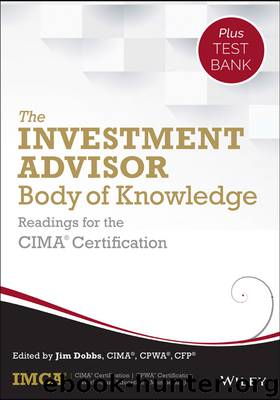The Investment Advisor Body of Knowledge + Test Bank by IMCA

Author:IMCA
Language: eng
Format: epub
ISBN: 9781118912348
Publisher: Wiley
Published: 2015-02-12T00:00:00+00:00
EFFICIENT VERSUS INEFFICIENT ASSET CLASSES
Another way to distinguish alternative asset classes is based on the efficiency of the marketplace. The U.S. public stock-and-bond markets are generally considered to be the most efficient marketplaces in the world. Often, these markets are referred to as “semi-strong efficient.” This means that all publicly available information regarding a publicly traded corporation, both past information and present, is fully digested in that company's traded securities.
Yet inefficiencies exist in all markets, both public and private. If there were no informational inefficiencies in the public equity market, there would be no case for active management. Nonetheless, whatever inefficiencies do exist, they are small and fleeting. The reason is that information is easy to acquire and disseminate in the publicly traded securities markets. Top-quartile active managers in the public equity market earn excess returns (over their benchmarks) of approximately 1 percent a year.
In contrast, with respect to alternative assets, information is very difficult to acquire. Most alternative assets (with the exception of commodities) are privately traded. This includes private equity, hedge funds, and credit derivatives. The difference between top-quartile and bottom-quartile performance in private equity can be as much as 25 percent.
Consider venture capital, one subset of the private equity market. Investments in start-up companies require intense research into the product niche the company intends to fulfill, the background of the management of the company, projections about future cash flows, exit strategies, potential competition, beta testing schedules, and so forth. This information is not readily available to the investing public. It is time consuming and expensive to accumulate. Furthermore, most investors do not have the time or the talent to acquire and filter through the rough data regarding a private company. One reason why alternative asset managers charge large management and incentive fees is to recoup the cost of information collection.
This leads to another distinguishing factor between alternative investments and the traditional asset classes: the investment intermediary. Continuing with our venture capital example, most investments in venture capital are made through limited partnerships, limited liability companies, or special-purpose vehicles. It is estimated that 80 percent of all private equity investments in the United States are funneled through a financial intermediary.
Investments in alternative assets are less liquid than their public market counterparts. Investments are closely held and liquidity is minimal. Furthermore, without a publicly traded security, the value of private securities cannot be determined by market trading. The value of the private securities must be estimated by book value or appraisal, or determined by a cash flow model.
Download
This site does not store any files on its server. We only index and link to content provided by other sites. Please contact the content providers to delete copyright contents if any and email us, we'll remove relevant links or contents immediately.
Rich Dad Poor Dad by Robert T. Kiyosaki(6185)
Pioneering Portfolio Management by David F. Swensen(6083)
How To Win Friends and Influence People by Dale Carnegie(4338)
The Money Culture by Michael Lewis(3850)
The Dhandho Investor by Mohnish Pabrai(3562)
The Wisdom of Finance by Mihir Desai(3528)
Liar's Poker by Michael Lewis(3228)
The Intelligent Investor by Benjamin Graham Jason Zweig(2930)
The ONE Thing by Gary Keller(2920)
Mastering Bitcoin: Programming the Open Blockchain by Andreas M. Antonopoulos(2894)
Fooled by Randomness: The Hidden Role of Chance in Life and in the Markets by Nassim Nicholas Taleb(2861)
Rich Dad Poor Dad: What The Rich Teach Their Kids About Money - That The Poor And Middle Class Do Not! by Robert T. Kiyosaki(2836)
Investing For Dummies by Eric Tyson(2797)
How to Win Friends and Influence People by Dale Carnegie(2796)
How to Day Trade for a Living: Tools, Tactics, Money Management, Discipline and Trading Psychology by Andrew Aziz(2786)
Market Wizards by Jack D. Schwager(2543)
Zero Hour by Harry S. Dent Jr. & Andrew Pancholi(2535)
How to Pay Zero Taxes, 2018 by Jeff A. Schnepper(2503)
Rich Dad's Guide to Investing by Robert T. Kiyosaki(2412)
